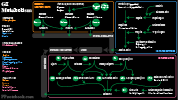Abdominal Anatomy, Abdomen, Gastrointestinal Anatomy, Gastrointestinal System, Digestive System, Gastrointestinal Tract, GI Tract, Alimentary Tract, Digestive Tract, Gastrointestinal Metabolism, Protein Metabolism, Lipid Metabolism, Fat Metabolism, Digestion, Intrinsic Factor, Secretin, Gastric inhibitory peptide, Cholecystokinin, Leptin, Peptide YY, Ghrelinn
- See Also
- Carbohydrate Metabolism
- Musculoskeletal Anatomy of the Abdomen
- Vascular Anatomy of the Abdomen
- Lymphatic Anatomy of the Abdomen
- Neurologic Anatomy of the Abdomen
- Spleen Anatomy
- Stomach Anatomy
- Pancreas Anatomy
- Liver Anatomy
- Bowel Anatomy
- Rectal Anatomy
- Pelvic Anatomy
- Adrenal Anatomy
- Renal Anatomy
- Bladder Anatomy
- Retroperitoneal Anatomy
- Physiology
- Gastrointestinal Motility
- Chewing (mastication)
- Chewing breaks apart food for greater surface area, allowing for later processing and absorption
- Nerve control: CN 5 (Trigeminal Nerve)
- Muscles of Mastication
-
Swallowing
- See Swallowing
- See Dysphagia
- Oropharyngeal Stage
- Esophageal Stage
- Peristalsis
- See Ileus
- See Constipation
- See Diarrhea
- Peristalsis propels food from the Stomach forward through the intestinal tract
- Timing
- Solid Food exits the Stomach after 1-3 hours
- Food exits the Small Intestine (at the ileocecal valve) after 4-6 hours
- Food exits the colon with Defecation typically after 1-2 days
- Nerve Control: CN 10 (Vagal Nerve)
- Stimulates peristalsis
- Myenteric Plexus (Auerbach's plexus) between the bowel's circular and longitudinal Muscles
- Examples of dysfunction: Achalasia, Hirschsprung's Disease
- Relaxes sphincters
- Promotes glandular secretion
- Meissner's Plexus in the submucosal layer
- Stimulates peristalsis
- Physiology
- Energy Sources
- Background
- Ingested food is lysed into small component molecules for intestinal absorption
- Starches and Disaccharides are lysed into Monosaccharides
- Proteins are lysed into Amino Acids and some short-chain peptides
- Fats are lysed into free Fatty Acids and Cholesterol
- Intestinal epithelial cell absorption
- Simple diffusion (passive absorption) of free Fatty Acids, monoglycerides and water
- Active transport (esp. Sodium-Potassium ATPase pump) for most other molecules
- Portal circulation carries most absorbed energy sources to liver (except fats)
- Carbohydrates (the Monosaccharides Glucose, fructose and galactose)
- Proteins (Amino Acids and short-chain peptides)
- Short fatty-acids (remainder of fats are carried by Lymphatics)
- Lymphatics carry most absorbed fats
- Fats are carried by Chylomicrons via Lymphatics after intestinal absorption (see below)
- Malabsorption has many mechanisms
- Lactose Intolerance (Lactase Deficiency)
- Pernicious Anemia (Vitamin B12 Deficiency from Intrinsic Factor deficiency)
- Celiac Disease (gluten-mediated injury to intestinal villi)
- Ingested food is lysed into small component molecules for intestinal absorption
-
Carbohydrates (4 kcals/g)
- See Carbohydrate Metabolism
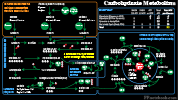
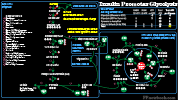
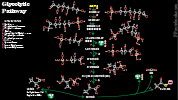
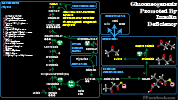
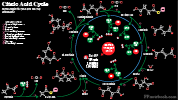
- Stores exhausted in first day of starvation
- Starches and Disaccharides are cleaved into Monosaccharides before intestinal absorption
- Mediated by Stomach acid and Salivary, intestinal and Pancreatic Enzymes (see below)
- Starches (Glucose polymers, cleaved by amylase into maltose)
- Glycogen
- Amylose
- Disaccharides
- Monosaccharides
- Glucose
- Fructose
- Galactose
-
Protein (4 kcals/g)
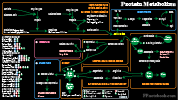
- Last to be catabolized in starvation
- Proteins are broken down to Amino Acids and some small peptides before absorption
- Mediated by Stomach acid, pepsin, trypsin and peptidases (see below)
- Proteins (polypeptides)
- Long chains of peptides (which in turn are chains of Amino Acids)
- Peptides
- Short chains of Amino Acids (two or more)
- Amino Acids
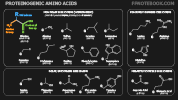
- Twenty common, Proteinogenic, Amino Acids occur in humans, in which 9 are essential (must be ingested)
- Fat (9 kcals/g)
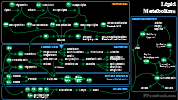
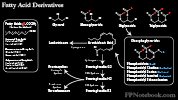
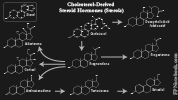
- Long term energy source
- Intestinal Digestion and Absorption of fats
- Duodenal bile salts emulsify fats into small droplets
- Enzymatic breakdown by intestinal and pancreatic agents
- Lipase (intestinal, pancreatic) lyse Triglycerides to monoglycerides and free Fatty Acids
- Esterases lyse Cholesterol to free Cholesterol and free Fatty Acids
- Phospholipases lyse phospholipids to free Fatty Acids and lysophospholipids
- Small micelles form from fat breakdown products and bile acids
- Micelles carry fats to intestinal epithelial cell brush border for absorption
- Bile salts allow for absorption of polar lipids
- Bile salts are reclaimed by enterohepatic circulation
- Bile salts absorbed in ileum are transported back to liver via portal circulation
- Intestinal Epithelial cell Processing of Fats
- Re-forming of lipids
- Triglycerides re-form from free Fatty Acids and monoglycerides
- Cholesterol esters re-form from free Fatty Acids and Cholesterol
- Phospholipids re-form from free Fatty Acids and lysophospholipids
- Chylomicrons
- Form from Apoproteins combined with Triglycerides, Cholesterol to phospholipids
- Chylomicrons move from intestinal epithelial cells into Lymphatic System
- Triglycerides are carried by Chylomicrons to Muscle and fat cells
- Triglycerides are lysed into free Fatty Acids by capillary LipoproteinLipase
- Free Fatty Acids are then absorbed by Muscle and fat cells
- Triglycerides reform from free Fatty Acids within Muscle and fat cells (esterification)
- Other Lipoproteins (VLDL, LDL, HDL)
- Form from Cholesterol processing in the liver
- Re-forming of lipids
- Physiology
- Digestion Mediators
- Images
- Background
- Some promoters of Digestion at one level inhibit Digestion proximally
- Cholecystokinin promotes Pancreatic Enzyme and Gall Bladder function, while inhibiting gastric motility
- Secretin promotes hepatic bile acid secretion, but decreases Gastrin secretion (and gastric and intestinal function)
- Local neurologic negative feedback loops also modify intestinal function
- Small Bowel distention decreases gastric motility and delays gastric emptying
- Digestion Mechanisms
- Hydrolysis
- Addition of water in process of cleaving complex Carbohydrates, Proteins and fats
- Hydrolysis
- Gastrointestinal mucosa is protected from acidity (bicarbonate secretion) and digestive enzymes (mucous secretion)
- Protective factors decreased by NSAIDs and Aspirin, emotional stress, Helicobacter Pylori
- Examples of dysfunction: Cystic Fibrosis, Peptic Ulcer Disease
- Some promoters of Digestion at one level inhibit Digestion proximally
- Mouth
- Salivary Amylase
- Breaks down starches (to maltose and other sugars)
- Salivary Amylase
-
Stomach
- Background
- Pepsinogen
- Hydrochloric Acid (HCL)
- Breaks down starches
- Aids in mineral absorption and bacterocidal activity
- Released by parietal cells
- Triggered by Vagus Nerve, Gastrin, Histamine and Proteins within the Stomach
- Intrinsic Factor
- Glycoprotein released by parietal cells
- Intrinsic Factor deficiency occurs in Pernicious Anemia (Vitamin B12 Deficiency)
- Facilitates Vitamin B12 absorption from Small Intestine
- Triggered by Stomach and duodenal distention
- Suppressed by low gastric pH and intestinal fat
-
Gastrin
- Stimulates HCl acid secretion by parietal cells and enzyme secretion from Pancreas
- Also increases peristalsis and relaxes pyloric sphincter and ileocecal valve
- Released from Gastrin cells in Stomach antrum
- Stimulated by Vagus Nerve, duodenal distention and Proteins within the Stomach
- Suppressed by Secretin, gastric inhibitory polypeptide and decreased Stomach pH
- Abnormally increased in Zollinger Ellison Syndrome (gastrin Secreting tumor)
-
Small Intestine
- Background
- Intestinal mucosa is protected by an alkaline mucus (from Brunner's Glands)
- Epithelial cells in Crypts of Lieberkuhn (within intestinal villi)
- Release most intestinal digestive enzymes (aside from Pancreatic Enzymes)
- Stimulated by Vagus Nerve and direct contact with food
- Carbohydrate Digestion
- Protein Digestion
- Peptidases
- Cleaves peptides into Amino Acids
- Enterokinase
- Activates trypsinogen to trypsin
- Activates chymotrypsinogen to chymotrypsin
- Activates procarboxypolypetidase to carboxypolypetidase
- Peptidases
- Fat and Cholesterol Digestion
- Intestinal Lipase
- Metabolizes lipids to Glycerol and Fatty Acids
- Intestinal esterases
- Metabolize Cholesterol esters to free Cholesterol and Fatty Acids
- Intestinal Lipase
- Other enzymes
- Secretin
- Polypeptide (27 Amino Acids) secreted from duodenal and jejunal mucosa
- Functions
- Decreases Gastrin secretion, and gastric acid secretion
- Decreases intestinal motility
- Promotes Stomach pepsin release
- Promotes bile acid secretion from liver
- Promotes bicarbonate secretion (and water) from Pancreas
- Lowers Serum Glucose
- Factors that increase Secretin levels
- Vagal Nerve Stimulation
- Food, fat or acid within the Small Intestine
- Gastric inhibitory peptide (GIP)
- Decreases Gastrin secretion
- Decreases gastric emptying
- Cholecystokinin
- Polypeptide (33 Amino Acid) secreyted from the upper small intestinal mucosa
- Functions
- Decreases gastric motility
- Promotes Pancreatic Enzyme and bicarbonate secretion
- Promotes Gall Bladder contraction and sphincter of oddi relaxation (intestinal bile acid secretion)
- Vasodilates intestinal mucosa vessels
- May also mediate satiety
- Factors that increase Cholecystokinin levels
- Fatty Acids in the duodenum (some Amino Acids can also stimulate release)
- Vagal Nerve Stimulation
- Bulbogastrone
- Suppresses acid secretion from gastric parietal cells
- Secretin
- Background
-
Pancreas
- Background
- Bicarbonate secreted by pancreatic ductule cells neutralizes Stomach acid in the duodenum
- In Pancreatitis, exocrine enzymes are activated while still within the Pancreas, resulting in inflammation
- Exocrine Cell Secreted Enzymes (vagal stimulated, as well as by cholecystokynin and Secretin)
- Amylase
- Breaks down starch to Oligosaccharides and ultimately sugars (e.g. Glucose, maltose)
- Trypsinogen
- Enterokinase (enteropeptidase) activated to trypsin
- Trypsin cleaves Proteins into peptides and Amino Acids
- Trypsin also activates Chymotrypsinogen and Procarboxypolypeptidase
- Chymotrypsinogen
- Trypsin activated to chymotrypsin
- Chymotrypsin is a protease (cleaves Proteins into peptides and Amino Acids)
- Procarboxypolypeptidase
- Trypsin activated to carboxypolypeptidase
- Carboxypolypeptidase is a protease that cleaves Proteins at their C-Terminal end
- Lipase (pancreatic Lipase, steapsin)
- Hydrolyzes Triglycerides into Fatty Acids and monoglycerides
- Cholesterol esterase
- Breaks down Cholesterol ester into free Cholesterol and Fatty Acids
- Phospholipase
- Hydrolyzes phospholipids into Fatty Acids
- Nuclease (nucleodepolymerase, polynucleotidase)
- Cleaves DNA and RNA Nucleic Acids into Nucleotides
- Amylase
- Endocrine Enzymes
- Insulin
- Secreted by pancreatic beta islet cells
- Promotes liver, fat and Muscle Cell update of Blood Glucose
- Increases Triglyceride synthesis, and glycogen synthesis (when Glucose levels are high)
- Increases intestinal motility
- Glucagon
- Secreted by pancreatic alpha islet cells in response to low Blood Glucose levels
- Stimulates glycogenolysis and Gluconeogenesis, increasing Blood Glucose concentration
- Stimulates lipolysis, increasing blood Fatty Acid concentration
- Decreases intestinal motility
- Somatostatin
- Secreted by pancreatic delta islet cells
- Triggered by increased Blood Glucose and Amino Acid concentrations
- Also secreted by the Hypothalamus with CNS effects (decreased GH, TSH, Prolactin)
- Inhibits Insulin and Glucagon secretion, as well as pancreatic exocrine enzyme secretion
- Decreases gastric acid secretion by direct action at parietal cells
- Decreases gastric emptying and peristalsis
- Secreted by pancreatic delta islet cells
- Insulin
- Background
-
Liver (Hepatocytes)
- Bile Acids and Salts
- Bile acids surround ingested lipids (forming micelles) and aid in lipid intestinal aborption
- Bile acid emulsified fats are also more easily catalyzed by Lipase
- Micelles transport lipids to intestinal villi for absorption
- Primary bile acids are derivatives of Cholic acid and Chenodeoxycholic Acid
- Produced via CYP450 mediated Cholesterol metabolism
- Circulate through the intestinal tract and reabsorbed and reclaimed
- A smaller amount (600 mg) of bile acids are lost in stool and sythesized each day in the liver
- Bile acids surround ingested lipids (forming micelles) and aid in lipid intestinal aborption
- Bile Pigment
- Bilirubin and Biliverdin are breakdown products of Hemoglobin
- Bilirubin is conjugated in the liver and excreted into common bile duct in bile
- Fat-Soluble Vitamin Storage and Metabolism
- Drug Metabolism and Detoxification
- Cytochrome P450 mediated Drug Metabolism (oxidation, reduction and hydrolysis)
- Drug conjugation for excretion
- Bile Acids and Salts
- Gallbladder
- Stores bile produced in the liver
- Gall Bladder contraction and release of bile acids into duodenum on ingestion of lipids
- Stimulated by Cholecystokinin
- Inhibited by vagal nerve
-
Large Bowel
- Mucous and epithelial cells secrete mucus and bicarbonate
- Activity
- Lubricates and protects the colon lining
- Solidifies stool
- Neutralizes Bacterial Toxins
- Control
- Triggered by direct food contact
- Triggered by vagal nerve stimulation
- Suppressed by Sympathetic System
- Activity
- Mucous and epithelial cells secrete mucus and bicarbonate
- Physiology
- Appetite Modifiers
- Leptin
- Protein secreted from adipose tissue (Protein increases relative to adipose amount)
- Triggers Hypothalamus to suppress feeding
- Peptide YY (PYY)
- Peptide released from ileum and colon to decrease appetite
- Increases after meals, and decreases while Fasting
- Ghrelin
- Anatomy
- Images
-
 Lewis (1918) Gray's Anatomy 20th ed (in public domain at Yahoo or BartleBy)
Lewis (1918) Gray's Anatomy 20th ed (in public domain at Yahoo or BartleBy)
-
 Lewis (1918) Gray's Anatomy 20th ed (in public domain at Yahoo or BartleBy)
Lewis (1918) Gray's Anatomy 20th ed (in public domain at Yahoo or BartleBy)
-
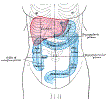 Lewis (1918) Gray's Anatomy 20th ed (in public domain at Yahoo or BartleBy)
Lewis (1918) Gray's Anatomy 20th ed (in public domain at Yahoo or BartleBy)
-
 Lewis (1918) Gray's Anatomy 20th ed (in public domain at Yahoo or BartleBy)
Lewis (1918) Gray's Anatomy 20th ed (in public domain at Yahoo or BartleBy)
-
 Lewis (1918) Gray's Anatomy 20th ed (in public domain at Yahoo or BartleBy)
Lewis (1918) Gray's Anatomy 20th ed (in public domain at Yahoo or BartleBy)
-
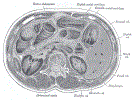 Lewis (1918) Gray's Anatomy 20th ed (in public domain at Yahoo or BartleBy)
Lewis (1918) Gray's Anatomy 20th ed (in public domain at Yahoo or BartleBy)
-
 Lewis (1918) Gray's Anatomy 20th ed (in public domain at Yahoo or BartleBy)
Lewis (1918) Gray's Anatomy 20th ed (in public domain at Yahoo or BartleBy)
-
 Lewis (1918) Gray's Anatomy 20th ed (in public domain at Yahoo or BartleBy)
Lewis (1918) Gray's Anatomy 20th ed (in public domain at Yahoo or BartleBy)
- References
- Goldberg (2014) Clinical Physiology, Medmasters, Miami, p. 120-31
- Kalra, Yetiskul, Wehrle, Tuma. (2021) Liver physiology, StatPearls, accessed 1/7/2022 online
